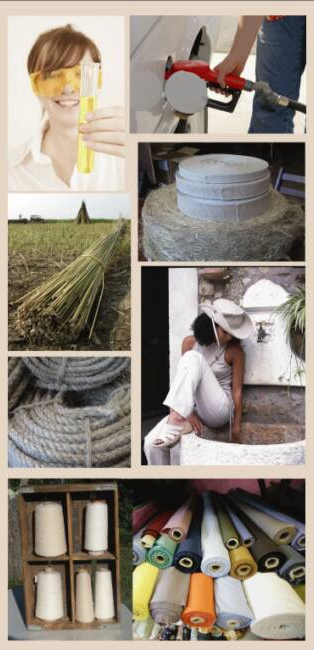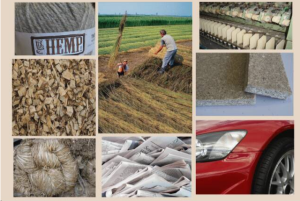The Fiber of the Future
 Hemp is, overall, the strongest, most durable, longest-lasting natural soft fiber on Earth! With it’s unparalleled strength, resiliency, and anti-fungal/anti-microbial properties, it is the fiber of choice for eco-conscious clothing and apparel. What’s more, it requires no synthetic pesticides or herbicides to grow, making hemp clothing a sustainable and responsible choice for your heath and the health of the environment. In recent years, both consumers and famous fashion designers have recognized the benefits and innovative uses of this miracle fiber.
Hemp is, overall, the strongest, most durable, longest-lasting natural soft fiber on Earth! With it’s unparalleled strength, resiliency, and anti-fungal/anti-microbial properties, it is the fiber of choice for eco-conscious clothing and apparel. What’s more, it requires no synthetic pesticides or herbicides to grow, making hemp clothing a sustainable and responsible choice for your heath and the health of the environment. In recent years, both consumers and famous fashion designers have recognized the benefits and innovative uses of this miracle fiber.“I believe that hemp is going to be the fiber of choice in both the home furnishings and fashion industries and I wanted to be one of the first designers to use this fabric in an innovative way. I love the fabric. The plan is for us to eventually introduce 100-percent hemp products.” – Calvin Klein, New York Times, June 1995.
Among it’s many phenomenal properties, clothing and apparel fabrics containing at least 50-percent hemp block the sun’s ultraviolet rays more effectively than do other fabrics, according to the Chinese Academy of Sciences. Combined with anti-microbial and anti-fungal properties, hemp does not trap odor-causing bacteria like cotton or synthetic fibers, making it an ideal choice for outdoor activities. It also resists shrinkage and stays true to colors under repeated washings.
With cotton leading the way in the world fabric market, what advantages does hemp possess in a head-to-head comparison?
Instead of Cotton
Our ancestors were well aware that hemp is softer than cotton, warmer than cotton, more water absorbent than cotton, has three times the tensile strength of cotton, and is many times more durable than cotton. Fifty percent of all chemicals used in American agriculture today are used in cotton growing. Hemp requires no synthetic chemicals to grow and has very few weed or insect enemies… except for the U.S. government and the DEA, of course.
Cotton is one of the most environmentally destructive agricultural crops, annually using over 275 million pounds of pesticides in the U.S. alone. This in addition to massive quantities of fertilizers, defoliants, growth regulators, and general biocides such as methyl bromide.
Conventional cotton refers to cotton grown with the aid of chemical pesticides, fertilizers, defoliants, and herbicides. Conventional cotton occupies only 3% of the world’s farmland yet demands fully 25% of the world’s chemical pesticides and fertilizers. Conventional cotton textile manufacturing involves bleaches, formaldehyde and other chemical finishes. These lead to chemical residues, which may result in skin irritation and respiratory problems. With children, these problems can persist well into their adult years.
Hemp is four times more water absorbent than cotton. Imagine the possibilities with hemp towels, bed sheets, and diapers! Hemp fiber bundles are up to fifteen feet long, while cotton fibers are a mere three-quarters of an inch, which gives hemp eight times the tensile strength and four times the durability of cotton. In regards to fiber yield per acre, one acre of hemp can produce as much usable fiber as 4 acres of trees or two acres of cotton.
With it’s superior yield, sustainability, strength, warmth, and absorbency, hemp outpaces cotton on every level! You’ll be happy to know that not only does hemp fiber create exciting and fashionable clothing, it also makes a great addition to body and personal care items.
Hemp Wood and Building Materials
 Hemp’s woody core is what is left once the long fibers are removed. This incredible source of biomass grows in just a few months – producing four times more wood than an acre of trees.
Hemp’s woody core is what is left once the long fibers are removed. This incredible source of biomass grows in just a few months – producing four times more wood than an acre of trees.
The reality of using hemp to produce our wood products, paper, plastics, oils and more – is just around the corner. It is only a matter of time before each state reaches full legalization and realizes industrial hemp’s potential.
By growing hemp in the U.S., it would provide local communities with a means to create new jobs via a new industry. The growers, harvesters, processors, manufacturers, and retailers would have a demand for new employees as business would grow exponentially and rapidly. By growing hemp in our communties, we would provide a wealth of new jobs and opportunities in an exciting and promising “community-based” economic model.
Reducing our dependence on fossil fuels, the petroleum industries, and our government means moving toward a self-sustaining way of life. Growing, harvesting, and using industrial hemp can be one of the foundations toward living “off the grid” and reducing our dependence on non-sustainable energy sources.
Check out the Hemp Materials online now.
[pt_view id=”7844608326″]
